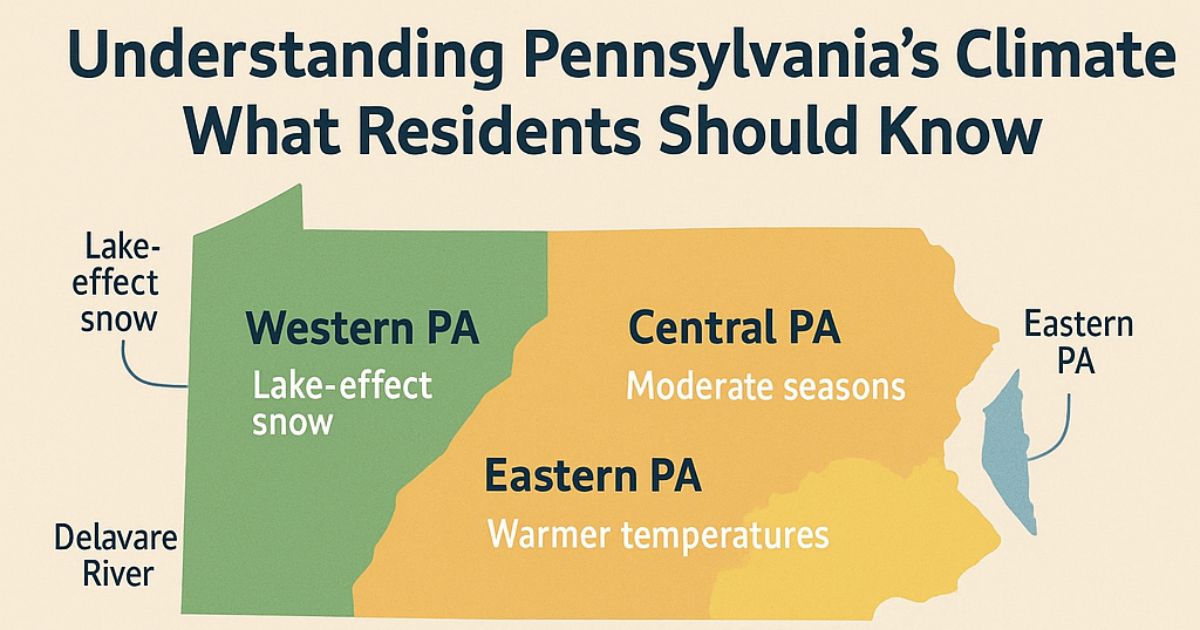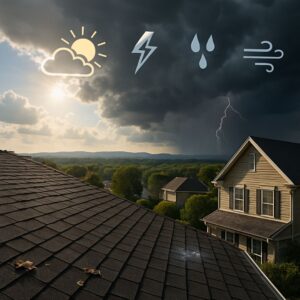
Stretching across mountains, valleys, forests, and bustling cities, Pennsylvania offers a rich blend of geography that significantly shapes its climate. From Lake Erie in the northwest to the Delaware River in the southeast, this varied landscape gives rise to unique weather patterns across the commonwealth. Understanding the Pennsylvania climate is essential for residents navigating seasonal changes, land use, and long-term planning.
Pennsylvania’s Climate Zones Explained
According to the Pennsylvania State Climatologist, the state’s weather patterns are shaped by its location in the mid-Atlantic region of the country. The state is divided into distinct regions such as the Ridge and Valley region, Lehigh Valley, and various mountainous areas, each with different climate normals.
In general, the climate of Pennsylvania is classified as humid continental, with cold winters and warm, often humid, summer months. Southeastern counties, including Philadelphia and its surrounding areas, tend to be warmer due to lower elevation and increased urban development. In contrast, the mountainous areas and northern counties experience colder temperatures and heavier snowfalls.
Seasonal Weather Patterns in Pennsylvania
Spring: This season brings frequent rainfall, budding forests, and increased flood risk due to snowmelt and thunderstorms. Ice jams in river valleys can also cause localized flooding.
Summer: The warm season typically spans from June through August, with July being the hottest month. High temperatures, thunderstorms, and occasional tornadoes can occur. The growing season thrives during this period, especially in the southeastern counties.
Fall: Marked by vibrant foliage and cooler temperatures, fall in Pennsylvania often experiences consistent rainfall. It’s also a transitional period for land use as agriculture winds down.
Winter: Cold and snowy conditions dominate, especially in the north and west. Cities like Pittsburgh experience steady snowfall, while areas near Lake Erie are prone to lake-effect snow. January is typically the coldest month, and transportation and infrastructure can be affected by snow and ice.
How Pennsylvania’s Climate Affects Daily Life
The Pennsylvania climate plays a key role in agriculture, transportation, and infrastructure. Three fourths of the state is covered in forests, which serve as both a resource and a buffer against floods and erosion. Rainfall and precipitation trends influence water supply, development, and industrial activity across cities and rural areas.
Land use is heavily shaped by climate conditions, with agriculture in the southeast and forested, mountainous areas in the west. Frequent precipitation supports a diverse growing season, though sudden shifts in weather can present challenges for farmers.
What Does This Mean for Your Roof?
Weather in Pennsylvania isn’t just a passing concern — it’s a direct factor in the longevity and safety of your roof. From ice dams and snow loads in the winter to moisture and mold from rainy spring and fall months, the roof of your home experiences year-round stress.
If you live in the valley region or any of the local areas we serve, regular inspections and timely repairs are essential. Many homeowners in the region are already seeing the effects of climate change, with more frequent storms and unpredictable seasonal shifts.
Explore our local Pennsylvania roofing services:
- Chambersburg PA roofing services
- Franklin County PA roofing services
- Waynesboro PA roofing services
- Gettysburg PA roofing services
- Carroll Valley PA roofing services
- Fairfield PA roofing services
- Greencastle PA roofing services
Our expert team offers free estimates and reliable solutions designed to withstand Pennsylvania’s climate extremes.
Looking Ahead: Climate Change and the Future of Pennsylvania
Climate data and projections from both federal and state agencies show clear trends. The average temperature in Pennsylvania has increased, and this trend is expected to continue. Changing climate normals suggest longer growing seasons, more intense rainfall events, and warmer winters.
This shift has prompted efforts across the commonwealth to reduce emissions, plan for sustainable land development, and protect vital resources. From industrial sectors to local municipalities, there is growing focus on how to adapt transportation, agriculture, and residential infrastructure to meet the future climate challenges.
Embracing Pennsylvania’s Climate with Preparedness
Pennsylvania’s climate is as complex as its geography, offering both opportunities and challenges. Whether you live in the southeast near Philadelphia or in the colder mountainous regions of the west, staying informed helps you adapt. By preparing for what’s expected and understanding the patterns we’ve already observed, residents can make smart decisions for their homes, communities, and future.
FAQs
What does “about one third” refer to in Pennsylvania’s climate context?
“About one third” often refers to the portion of Pennsylvania’s geography—such as its mountainous or forested areas—or to segments of observed climate patterns like snowfall or rainfall distribution across the state.
How does Pennsylvania’s climate compare to other states?
Compared to other states, Pennsylvania has a more varied climate due to its unique geography. While it shares a humid continental climate with many northern states, its mix of valleys, mountains, and proximity to the coast create more localized and diverse weather patterns.
How much rain does Pennsylvania receive on average?
Pennsylvania typically receives between 40 and 50 inches of precipitation annually, though this can vary by region. Western and mountainous portions often see higher totals due to orographic lift and lake-effect patterns.
What climate changes have been noted recently?
Noted changes include rising average temperatures, increased frequency of heavy rain events, and a longer growing season. These changes align with broader national and global climate trends.
What is this page’s main focus?
This page focuses on providing residents with a clear understanding of Pennsylvania’s climate, including seasonal weather trends, regional impacts, and how these factors influence daily life and home care.
How is the southern part of Pennsylvania different climatically?
The southern portion of Pennsylvania, especially the southeastern counties, tends to experience warmer temperatures, longer growing seasons, and more urban heat island effects compared to the mountainous north and west.
What are projected future changes to Pennsylvania’s climate?
Projected changes include warmer winters, increased rainfall intensity, and more frequent extreme weather events. Climate models also indicate potential shifts in growing seasons and flood risks.
Are certain portions of Pennsylvania more vulnerable to climate change?
Yes, portions of southeastern Pennsylvania are more vulnerable due to population density and development, while western and mountainous areas face risks from heavy snowfall, erosion, and changing forest health.
How does the western half of the state differ in climate?
The western half of Pennsylvania, including Pittsburgh and surrounding regions, experiences more cloud cover, higher snowfall totals, and cooler temperatures than the eastern half.
How often do extreme weather events occur in Pennsylvania?
The frequency of extreme weather events, such as heavy thunderstorms, floods, and snowstorms, has increased in recent decades. Climate change is expected to further amplify these trends.



